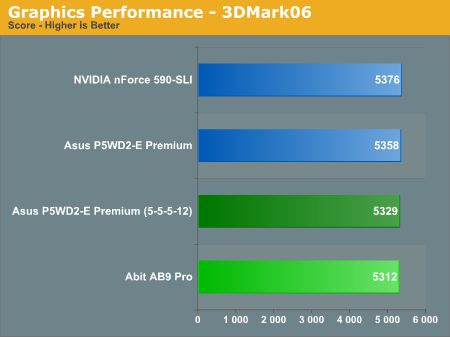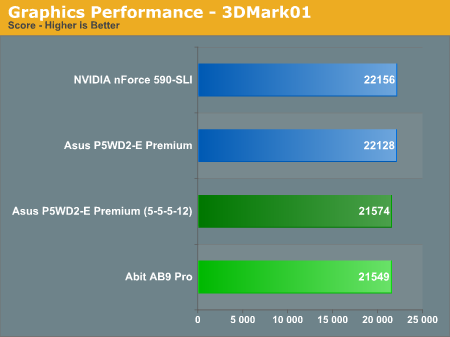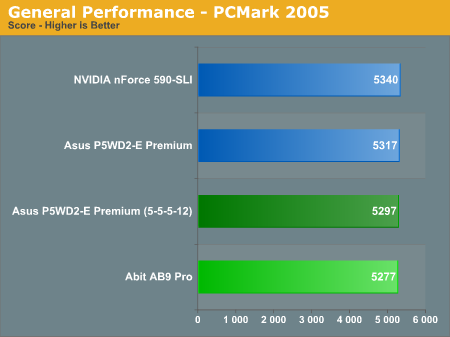Abit AB9 Pro: A sneak peek at Intel's new P965 chipset
by Gary Key on July 3, 2006 3:45 AM EST- Posted in
- Motherboards
Synthetic Graphics Performance
The 3DMark series of benchmarks developed and provided by Futuremark are among the most widely used tools for benchmark reporting and comparisons. Although the benchmarks are very useful for providing apple to apple comparisons across a broad array of GPU and CPU configurations, they are not a substitute for actual application and gaming benchmarks. In this sense we consider the 3DMark benchmarks to be purely synthetic in nature but still valuable for providing consistent measurements of performance.


In our first tests, each platform score is so close that there is no winner here. In the memory and CPU sensitive 3DMark01 benchmark we see the Asus and Abit boards scoring extremely close at the same memory timings. Although we have not reported memory benchmarks scores in this article, the Abit and Asus boards performed almost identically at the same settings indicating the P965 Express chipset will have excellent memory performance.
General System Performance
The PCMark05 benchmark developed and provided by Futuremark was designed for determining overall system performance for the typical home computing user. This tool provides both system and component level benchmarking results utilizing subsets of real world applications or programs. This benchmark is useful for providing comparative results across a broad array of graphics cards, CPUs, hard disks, and memory configurations and it also includes some multithreading results. In this sense we consider the PCMark benchmark to be both synthetic and real world in nature while providing consistency in our benchmark results.

The margins are extremely close in the PCMark05 results but the NVIDIA platform continues to show a very slight advantage over the Intel platform. While looking at the individual test results, we noticed the Abit board matched the other boards in the graphics tests and finished slightly behind in the multitasking tests due to the memory settings. We also noticed the NVIDIA nForce 500 Intel Edition board had 19% better performance than either Intel board in the XP Hard Disk Drive Startup test, with the ICH8R Abit performing 4% better than the ICH7R on the Asus.
The 3DMark series of benchmarks developed and provided by Futuremark are among the most widely used tools for benchmark reporting and comparisons. Although the benchmarks are very useful for providing apple to apple comparisons across a broad array of GPU and CPU configurations, they are not a substitute for actual application and gaming benchmarks. In this sense we consider the 3DMark benchmarks to be purely synthetic in nature but still valuable for providing consistent measurements of performance.


In our first tests, each platform score is so close that there is no winner here. In the memory and CPU sensitive 3DMark01 benchmark we see the Asus and Abit boards scoring extremely close at the same memory timings. Although we have not reported memory benchmarks scores in this article, the Abit and Asus boards performed almost identically at the same settings indicating the P965 Express chipset will have excellent memory performance.
General System Performance
The PCMark05 benchmark developed and provided by Futuremark was designed for determining overall system performance for the typical home computing user. This tool provides both system and component level benchmarking results utilizing subsets of real world applications or programs. This benchmark is useful for providing comparative results across a broad array of graphics cards, CPUs, hard disks, and memory configurations and it also includes some multithreading results. In this sense we consider the PCMark benchmark to be both synthetic and real world in nature while providing consistency in our benchmark results.

The margins are extremely close in the PCMark05 results but the NVIDIA platform continues to show a very slight advantage over the Intel platform. While looking at the individual test results, we noticed the Abit board matched the other boards in the graphics tests and finished slightly behind in the multitasking tests due to the memory settings. We also noticed the NVIDIA nForce 500 Intel Edition board had 19% better performance than either Intel board in the XP Hard Disk Drive Startup test, with the ICH8R Abit performing 4% better than the ICH7R on the Asus.










33 Comments
View All Comments
CYBERX1800XT - Thursday, July 6, 2006 - link
it's going to take alot to convince me that abit's quality in electroitics(resistors,capicitors,pnp transistors and voltage regulators) hasn't overshadowed there so-called new make over. all i have to say is 'anyone remember the abit be-6 revision 2?? i do,,i also remember 12 hours after buying an abit mobo,,at least 14 caps literally blew up. so all this halla-ballhooey about the product line refreshment may just be hype. i'm not scowling at anyone at anandtech,,i believe and trust there reviews. who i don't trust is abit's choice in 2nd or 3rd rate electroitics. besides,,who cares,,this is a rather whimpy board. for the cost of this mobo,,you could easily spend 20 more bucks and get a ASUS A8R-MVP,,and have crossfire to boot. i'm sorry to sound so negative,,but abit left a bad taste in my mouth in 2000. and it has yet to have left. i honestly apologize to everyone at anandtech. not demeaning any of you guys,i totally trust your revievs. but i switched to amd,,and i only bought 1 abit board. and that will never happen again. i will ONLY use ASUS!!!araczynski - Wednesday, July 5, 2006 - link
personally i find the inclusion of onboard audio on ALL motherboards to be quite the waste of consumer dollars. what kind of an "enthusiast" puts up with onboard audio? granted its more then fine for windows, but when you're aiming a mobo at an enthusiast you don't have to make him pay for some crappy soundchip that he'll never do more with then disable in the bios.and yes, get rid of the floppy connector (usb version for those that can't live without them).
Pirks - Wednesday, July 5, 2006 - link
Not quite that simple - it's actually cheaper to make mobos with audio than without it. With audio you have one manufacturing line cranking out mobos, just one model => CHEAP. If you wanna get mobos w/o audio, you gonna get TWO manufacturing lines cranking out mobos => EXPENSIVE. This is why they always produce only ONE SINGLE MOBO MODEL, EVERYTHING INCLUDED - all the floppy and legacy crap - 'cause that's CHEAP. You go to options, exclude this, exclude that blah blah - and the price -wooosh!- soars up to clouds and the blue sky :)bob4432 - Wednesday, July 5, 2006 - link
glad to see a floppy is still around. i am probably the only person that uses one, but i appreciatet the m/b manf for taking me into consideration :Dafrodite - Tuesday, July 4, 2006 - link
Say what!?!The problem here is the boneheaded optical drive manufacturers not using SATA on their drives, not Intel removing obsolete technology.
I say:
Get rid of PATA
Get rid of Floppy-drives
Get rid of mouse and keyboard ports
Then use all that lovely real estate on the board to put a digital tv receiver or bluetooth-module or wifi or firewire or just more USB-slots or whatever you want..
Please, what year is it now, 2006 or 1996.. floppydrive connectors on a "next-gen motherboard"??
mine - Saturday, July 8, 2006 - link
second thatiwhat about the following scenario.... you will never forget that :
3 young Mac videoeditors rolling on the floor with wet trousers looking @ a Windows XP install with an open case
an attached floppy and F6
these people have never seen a floppy in their whole life and these things are one click away on Mac OS X
Pirks - Tuesday, July 4, 2006 - link
Hmm, why this smells like a Mac? ;)JarredWalton - Tuesday, July 4, 2006 - link
Until we have the replacements ready, completely removing support for older technologies is jumping the gun. We need a next-generation operating system that doesn't ever require a floppy drive (which we will get with Windows Vista). More importantly, we need SATA optical drives that are at least as good as the PATA counterparts, and with equivalent prices. Right now, I'm only aware of one company making SATA DVDR drives (Plextor), and the consensus seems to be that the drives aren't all that great. Widespread support for SATA optical drives (meaning software support -- what good is a DVDR if your favorite burning application doesn't support it?) is still lacking.The end result is that every motherboard manufacturer that uses ICH8 is pretty much forced to include another chip on the motherboard to handle IDE support. Intel isn't getting rid of IDE support; they're just placing the burden of including such support on the motherboard manufacturers. Seriously, how many transistors does it take to support IDE? Perhaps the reason it was removed was to reduce pin counts on the Southbridge, but I doubt it. We're not even asking for anything special in terms of IDE support; just include the same old IDE support that has been present on motherboards for the past decade or so.
jonp - Monday, July 3, 2006 - link
Is the Zalman unit "stock"?
Gary Key - Monday, July 3, 2006 - link
We used the stock retail heatsink for all testing except overclocking. We use the Zalman for overclocking and also tried the Tuniq 120 for fitment issues.